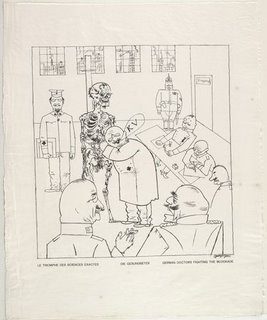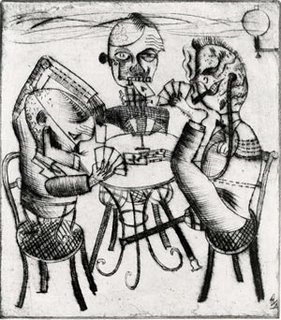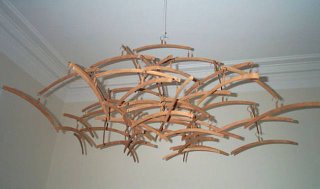Dada.

This is coolbert:
There was tremendous upheaval in the existing world order following the end of the Great War [WW1].
A physical upheaval when the various Empires and Kingdoms of pre-war Europe came crashing down in defeat.
There was also a tremendous psychological upheaval. The Christian, democratic, capitalist societies of Europe, and to a much lesser extent America, were NOT prepared mentally for the bloodletting of WW1.
What occurred in WW1 was totally unprecedented. A mechanized, industrialized, mass production type of war that had not been seen before. Romanticized, glorified war was gone forever [if it ever did exist!!]. Humans were mere infinitesimally small cogs in a hugely bigger machine. War was totally impersonalized. Each soldier was a number in an army of numbers.
The art world was also in a state of upheaval in the aftermath of the war.
Most demonstrably so in the art form [genre'] called Dada.
An art form that displayed it's revulsion for the war with weird, other-kinda forms of art that had never before been seen.
An art form that in some ways was grotesque to what existed before.
Well, that was the whole idea behind Dada. Grotesqueness to illustrate the grotesqueness of what WW1 had been.

A recent traveling exhibit of Dada art illustrates the genre'.
"Hey, "Dada"-Dude
Where's the Rest of Me?
[this is of course is a paraphrase from the very famous Ronald Reagan movie where the ex-Pres plays a man that has just woken up and found out his legs have been amputated!!]
Dada At the National Gallery of Art in Washington D.C., through May 14, 2006
Moving to The Museum of Modern Art in New York, June-Sept. 2006"
"The beginnings of Dada do not lie in art but in disgust, one of its leaders said . . . the war of 1914 divided the sympathies not only of intellectuals of various European countries, but of their avant-garde movements as well . . . the poets and artists who were to call themselves Dadaists were pacifists and internationalists. Most of them were draft-dodgers on the run from military authorities in their respective countries. Their revulsion at the butchery of the Great War, in which about ten million men died, over twenty million were wounded, and several hundred thousand lost limbs and sight, had a lot to do with what Dada was to become."
"From a psychological standpoint I find the spectacle of war very impressive," Marcel Duchamp said in 1915 shortly after his arrival in New York. "The instinct which sends men marching out to cut down other men is an instinct worthy of careful scrutiny. What an absurd thing such a conception of patriotism is!... Personally I must say I admire the attitude of combating invasion with folded arms."
"Thanks to the diaspora of artists caused by the Great War, Dada arrived in New York. The American version wasn't as polemical as European Dada, but it was plenty informed by the carnage it had fled. Jean Crotti's Clown (1916) is a plainly transitional piece: It's whimsically cute, but it hints at the rearrangement of bodies that was going on in Europe."
Dada achieved it's pinnacle of success in the years just after WW1. And then faded away. But did use "art" to make it's point about the "new world" that had emerged.
"nihilistic, anti-aesthetic and a reaction to the rationalization."
"Dada was many things, but it was essentially an anti-war movement in Europe and New York from 1915 to 1923. It was an artistic revolt and protest against traditional beliefs of a pro-war society."
"Dada was a moral and ethical response to the slaughter of World War I. In grief, rage, and despair, Dada used art to comment on the world, making art an indictment of the hypocrisies that wiped out a generation."
"the Dada attitude towards war: That it is chaos. That the world has gone mad. That war itself is craziness incarnate destroying humanity."
This latest exhibit of Dada art is DESIGNED to shock you:
"First, for historical context, gallery-goers enter a fittingly silent, gunship grey ante-chamber featuring three minutes of documentary footage about World War I. Crafted for this exhibit, scenes deftly move from Parisians enthusiastically grasping August, 1914 mobilization orders to the haunting otherworldliness of gas-masked children and animals, to the profusion of prostheses and face masks for amputees and the grands mutiles . . . Both killing and medicine grew more advanced, producing a flood of half-mechanical male veterans."
Dada used a variety of techniques to shock art viewers. For example:
* "Dada art catches these grim realities [of war] with missing limbs, re-mastered faces, and split craniums. Phallic hints in God, from a cast-iron plumbing trap, and Ernst's The Hat Makes the Man suggest phalanxes needing Viagra."
[persons with missing limbs hobbling around on peg-legs were a popular feature of Dada art.]
* "In Cologne dadaists focused on the psychological effects of war injuries and how the war had transformed men into stumps. (Berliners were plenty fascinated with this too.)"
* "Collage continues upstairs [at the exhibit of Dada art] along oxblood walls of Berlin Dada. Suspended from the ceiling is the handless, porcine dummy labeled Prussian Archangel. His army officer's waistband reads: "In order to understand this work of art completely, one should drill daily for 12 hours with a heavily packed knapsack..." . . . Works by wounded veteran Otto Dix both agitate and captivate, as with peg-legged War Cripples, ghoulish stand-ins for Cezanne's Cardplayers."

* "Man Ray's wonderful repeating coat hanger sculpture Obstruction, which hangs over the center of the New York Dada gallery . . . Obstruction reads as a commentary on the war. Man Ray specified that an infinite number of coat hangers could be used in the piece, to the point where coat hangers completely filled a room. With a simple consumer object -- Americans loved those! -- Man Ray mimicked the endless piling up of bodies in Europe."

[just a display of empty coat hangers. That was all the art "work" consisted of. Symbolic of they millions of dead no longer around to hang clothes on the hangers. - - Get it!!??]
Art portraying war prior to WW1 showed a dramatic, glorified aspect to it. Such as a scene showing Napoleon riding a horse triumphant across a battlefield, or Kellerman leading a cavalry charge that won the day. Etc.
Dada was NOT this!!
coolbert.
A physical upheaval when the various Empires and Kingdoms of pre-war Europe came crashing down in defeat.
There was also a tremendous psychological upheaval. The Christian, democratic, capitalist societies of Europe, and to a much lesser extent America, were NOT prepared mentally for the bloodletting of WW1.
What occurred in WW1 was totally unprecedented. A mechanized, industrialized, mass production type of war that had not been seen before. Romanticized, glorified war was gone forever [if it ever did exist!!]. Humans were mere infinitesimally small cogs in a hugely bigger machine. War was totally impersonalized. Each soldier was a number in an army of numbers.
The art world was also in a state of upheaval in the aftermath of the war.
Most demonstrably so in the art form [genre'] called Dada.
An art form that displayed it's revulsion for the war with weird, other-kinda forms of art that had never before been seen.
An art form that in some ways was grotesque to what existed before.
Well, that was the whole idea behind Dada. Grotesqueness to illustrate the grotesqueness of what WW1 had been.

A recent traveling exhibit of Dada art illustrates the genre'.
"Hey, "Dada"-Dude
Where's the Rest of Me?
[this is of course is a paraphrase from the very famous Ronald Reagan movie where the ex-Pres plays a man that has just woken up and found out his legs have been amputated!!]
Dada At the National Gallery of Art in Washington D.C., through May 14, 2006
Moving to The Museum of Modern Art in New York, June-Sept. 2006"
"The beginnings of Dada do not lie in art but in disgust, one of its leaders said . . . the war of 1914 divided the sympathies not only of intellectuals of various European countries, but of their avant-garde movements as well . . . the poets and artists who were to call themselves Dadaists were pacifists and internationalists. Most of them were draft-dodgers on the run from military authorities in their respective countries. Their revulsion at the butchery of the Great War, in which about ten million men died, over twenty million were wounded, and several hundred thousand lost limbs and sight, had a lot to do with what Dada was to become."
"From a psychological standpoint I find the spectacle of war very impressive," Marcel Duchamp said in 1915 shortly after his arrival in New York. "The instinct which sends men marching out to cut down other men is an instinct worthy of careful scrutiny. What an absurd thing such a conception of patriotism is!... Personally I must say I admire the attitude of combating invasion with folded arms."
"Thanks to the diaspora of artists caused by the Great War, Dada arrived in New York. The American version wasn't as polemical as European Dada, but it was plenty informed by the carnage it had fled. Jean Crotti's Clown (1916) is a plainly transitional piece: It's whimsically cute, but it hints at the rearrangement of bodies that was going on in Europe."
Dada achieved it's pinnacle of success in the years just after WW1. And then faded away. But did use "art" to make it's point about the "new world" that had emerged.
"nihilistic, anti-aesthetic and a reaction to the rationalization."
"Dada was many things, but it was essentially an anti-war movement in Europe and New York from 1915 to 1923. It was an artistic revolt and protest against traditional beliefs of a pro-war society."
"Dada was a moral and ethical response to the slaughter of World War I. In grief, rage, and despair, Dada used art to comment on the world, making art an indictment of the hypocrisies that wiped out a generation."
"the Dada attitude towards war: That it is chaos. That the world has gone mad. That war itself is craziness incarnate destroying humanity."
This latest exhibit of Dada art is DESIGNED to shock you:
"First, for historical context, gallery-goers enter a fittingly silent, gunship grey ante-chamber featuring three minutes of documentary footage about World War I. Crafted for this exhibit, scenes deftly move from Parisians enthusiastically grasping August, 1914 mobilization orders to the haunting otherworldliness of gas-masked children and animals, to the profusion of prostheses and face masks for amputees and the grands mutiles . . . Both killing and medicine grew more advanced, producing a flood of half-mechanical male veterans."
Dada used a variety of techniques to shock art viewers. For example:
* "Dada art catches these grim realities [of war] with missing limbs, re-mastered faces, and split craniums. Phallic hints in God, from a cast-iron plumbing trap, and Ernst's The Hat Makes the Man suggest phalanxes needing Viagra."
[persons with missing limbs hobbling around on peg-legs were a popular feature of Dada art.]
* "In Cologne dadaists focused on the psychological effects of war injuries and how the war had transformed men into stumps. (Berliners were plenty fascinated with this too.)"
* "Collage continues upstairs [at the exhibit of Dada art] along oxblood walls of Berlin Dada. Suspended from the ceiling is the handless, porcine dummy labeled Prussian Archangel. His army officer's waistband reads: "In order to understand this work of art completely, one should drill daily for 12 hours with a heavily packed knapsack..." . . . Works by wounded veteran Otto Dix both agitate and captivate, as with peg-legged War Cripples, ghoulish stand-ins for Cezanne's Cardplayers."

* "Man Ray's wonderful repeating coat hanger sculpture Obstruction, which hangs over the center of the New York Dada gallery . . . Obstruction reads as a commentary on the war. Man Ray specified that an infinite number of coat hangers could be used in the piece, to the point where coat hangers completely filled a room. With a simple consumer object -- Americans loved those! -- Man Ray mimicked the endless piling up of bodies in Europe."

[just a display of empty coat hangers. That was all the art "work" consisted of. Symbolic of they millions of dead no longer around to hang clothes on the hangers. - - Get it!!??]
Art portraying war prior to WW1 showed a dramatic, glorified aspect to it. Such as a scene showing Napoleon riding a horse triumphant across a battlefield, or Kellerman leading a cavalry charge that won the day. Etc.
Dada was NOT this!!
coolbert.

0 Comments:
Post a Comment
Subscribe to Post Comments [Atom]
<< Home